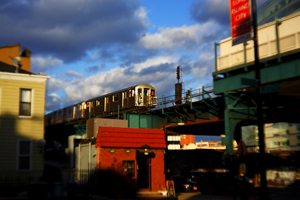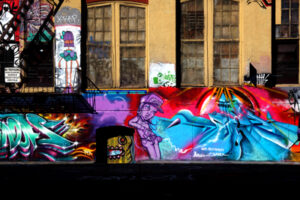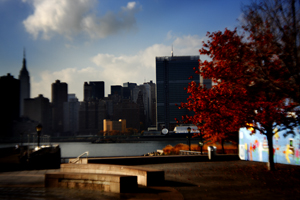
By Catherine Kirkpatrick
For art and urban scenery, Manhattan’s Chelsea district may be the destination of choice for visitors to New York, but with little more than a metro card and an adventurous spirit, unique visual experiences can be found all over town.

One of my favorite train lines is the No. 7. Boarding at Times Square or Grand Central Station in the Queens direction, you will get a sweeping view of Manhattan as the train rises from the ground at Hunters Point, a view made even more spectacular by the drab, low-lying landscape of Long Island City. But one building stands out.

Debarking from the train at Court Square and crossing Jackson Avenue, you will find yourself in front of a block long structure officially known as the 5Pointz Aerosol Art Center, unofficially as the “graffiti building.” Back in the 1970s and 80s, when almost every train, grate and wall in New York was covered with bright, sprawling illustration and personal “tags,” graffiti was seen as a visual expression of the city’s lawlessness and general decline. It was a symptom, not art.

But slowly the will to improve the city hardened and coalesced into policy, and in 1984, the New York City Transit Authority began a five-year program to eradicate “writing” from the subway trains. Graffiti became less prevalent yet more purposeful, influencing artists like Keith Haring and Jean-Michel Basquiat, finally entering the realm of museums and gallery spaces. The 5Pointz embraces the best of both worlds: the feeling of wild, spur of the moment outlaw art, along with formal elements of planning and design. It’s fabulous.
Graffiti is taken seriously here. There is an official 5Pointz website with information on the artists and their work, and tours are available. Who knows, chancing by you might even stumble upon a work in progress.
For art in a more formal setting, MoMA PS 1 is just a short walk away at 22-25 Jackson Avenue. Open Thursday through Monday, 12–6, it presents a wide range of contemporary art, including installations, music and performance. For information on this and other prominent art venues, check out the Long Island City Cultural Alliance website.

To take in another spectacular view, catch the No. 7 back toward Manhattan and get off at the Vernon Boulevard-Jackson Avenue stop. Head northeast on Jackson to 49th Avenue, then turn right onto the Pulaski, one of three bridges that run over Newtown Creek, connecting Brooklyn to Queens. The view of the three boroughs is even more beautiful on a bleak day, with clouds piling high over the towering peaks of Manhattan, and railroad tracks glinting up from their snaking trail along the water’s edge. There is a pedestrian path, but watch out for speeding cyclists, and note the mix of hipsters, artists, and working class people–a diverse cross section of the great City of New York.

For a lower, closer view of Manhattan, head west from the Vernon-Jackson stop toward the East River. In Gantry Plaza State Park, once a busy dock facility, huge hulking structures rise at the water’s edge–the gantries used to load and unload rail car barges–reminders of Long Island City’s industrial past. Today with ten acres of open space, spectacular landscaping, and refurbished piers that jut out into the water, it is a place of peace and reflection, especially beautiful as the sun falls down behind the tall buildings in the west.
Hop back on the No. 7 to return to Manhattan, remembering as with all things, that it’s not the destination so much as the journey that counts.
(Note: The pictures in this article were taken with a Canon 5D camera, some with a regular lens and some with a plastic Diana Camera lens attachment, hence the softer focus of some images.)

1 Comment on Art And Attractions Along New York’s No. 7 Line